|
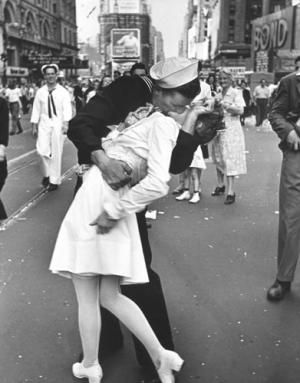
August 14, 1945, V-J Day, Times Square, New York City, photograph credit: Alfred Eisenstaedt, Life magazine
|
|
Sooner or later, all wars come to an end. When World War II ended after six long years in August 1945, the United States alone among war combatants emerged largely unscathed with enormous international prestige and domestic prosperity that was about to be unleashed in spectacular fashion. It would set into motion unprecedented cultural and social changes, the repercussions of which are still being felt today in American society.
A few months after that iconic photograph was taken in New York City, the first wave of the baby boom generation announced its arrival on the American scene
The end of World War II brought thousands of young servicemen back to America to pick up their lives and start new families in new homes with new jobs. With an energy never before experienced, American industry expanded to meet peacetime needs. Americans began buying goods not available during the war, which created corporate expansion and jobs. Growth everywhere. The baby boom was underway.
1. Introduction
|
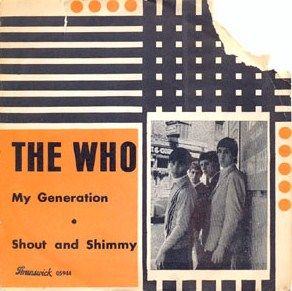
:: ::
My Generation
People try to put us d-down (Talkin' 'bout my generation)
Just because we get around (Talkin' 'bout my generation)
Things they do look awful c-c-cold (Talkin' 'bout my generation)
I hope I die before I get old (Talkin' 'bout my generation)
This is my generation
This is my generation, baby
Why don't you all f-fade away (Talkin' 'bout my generation)
And don't try to dig what we all s-s-say (Talkin' 'bout my generation)
I'm not trying to cause a big s-s-sensation (Talkin' 'bout my generation)
I'm just talkin' 'bout my g-g-g-generation (Talkin' 'bout my generation)
-- My Generation, The Who (1965), watch the video on YouTube
|
|
:: ::
It is virtually impossible to do justice to a subject this large, complex, and one covering several decades. This diary is neither the definitive history of this generation nor does it cover every single event that occurred during this period of enormous and consequential change in the country's history. I have, though, made an effort to cover major events and include many images that affected the lives of most baby boomers. By virtue of being on this blog since its inception, I know for a fact that hundreds -- if not many thousands of you -- actually lived through this period, internalized many of these changes, and have vivid memories of them. If you feel that I edited out an event or a series of events that are important to your being, do provide us with a description in the comments section that deepens our knowledge.
A few years ago I was having dinner with a Gen-Xer friend of mine and somehow the conversation drifted towards generational topics. At the time, she was in-between jobs and at one point my friend said this out of the blue
The baby boomers had the best sex. They had the best drugs. And, goddamnit, they hold all the best jobs.
I mention this conversation to make a larger point. Even though -- and as best as I can recall over the years -- there haven't been too many diaries written about boomers or other generations on this blog, nonetheless, such diaries invariably degenerate into stereotypical discussions, i.e., "all boomers are self-absorbed and narcissistic," "Gen-Xers are lazy and unmotivated," and so on. This is not that kind of diary. I've tried to include images (cartoons and posters in particular) that I hope many of you have never seen before and that they might, in a small way, shed new light in understanding this generation. So, given that I have invested a fair bit of time to research and write this diary, I ask that all of you restrain yourself and, instead, comment constructively on the larger issues and events discussed in this diary.
I look forward to your comments, insights, and observations. Thanks.
:: ::
2. The Vital Statistics
Whenever someone mentions the baby boom generation, several images from the 1960's immediately come to mind: civil rights marches, anti-war demonstrations, political assassinations, student sit-ins and riots, rock music, sexual freedom, fashion trends, cynicism about government, and much, much more. All of these events are rightly associated with this influential generation but as background information, I've detailed several important events and trends from the 1950's, ones that also contributed towards shaping their lives in their formative years.
A few interesting facts about boomers that I've collected from U.S. Census Bureau data and other sources

- The baby "boom" clearly begins when U.S. births increased from 2.86 million in 1945 to 3.41 million in 1946 for an increase of 19.2%.
- 33.94 million (or 44.8% of the total 75.8 million) were born between January 1, 1946 and December 31, 1954. (An updated 2009 report puts the revised number at 77.3 million)
- 41.86 million (55.2% of the total) were born between January 1, 1955 and December 31, 1964.
- The largest number of births in any single year were in 1957 when 4.3 million boomers were born. Why did it take over 10 years for births to reach their highest level? While this is speculative, my guess is that many of their parents were drafted or volunteered to serve in World War II right after high school in the 1940's. Upon their return, and taking advantage of the G.I. Bill, many didn't start or resume college life until they were in their twenties and waited to start families after establishing their careers. By the time the original G.I. Bill expired in 1956, 7.8 million World War II veterans had participated in an education or training program
- In 11 of the 19 years (from 1954-1964), births exceeded 4 million in each of these years. For the next generation (Gen-Xers), births did not exceed 4 million in any single year from 1965-1983. In fact, it wasn't until 1989 that births exceeded 4 million again.
- There were 1.05 male births for every one female birth. See this chart too.
- As of 2006, One-third of the employees in America were baby boomers with many expected to retire within the next decade, leaving a huge knowledge gap.
- For the 5-year period between 1956 and 1960, inclusive, 21.2 million boomers were born, the largest for any 5-year period in the 20th century.
- One of the reasons the boomers attracted so much attention early on in their lives was that in 1964 they represented about 40% of the population. Today, they are 28% of the U.S. population.
It is hard to generalize about a generation of almost 76 million strong. One approach is to divide the boomers into two groups with different experiences that have shaped their attitudes and beliefs
Baby Boomer Cohort #1 (born from 1946 to 1954)
- Memorable Events: assassination of JFK, Robert Kennedy, and Martin Luther King, political unrest, walk on the moon, Vietnam War, anti-war protests, social experimentation, sexual freedom, civil rights movement, environmental movement, women’s movement, protests and riots, experimentation with various intoxicating recreational substances.
- Key Characteristics: experimental, individualism, free spirited, social cause oriented.
Baby Boomer Cohort #2 (born from 1955 to 1964)
- Memorable Events: Watergate, Nixon resigns, the cold war, the oil embargo, raging inflation, gasoline shortages.
- Key Characteristics: less optimistic, distrust of government, general cynicism.
:: ::
3. The Early Years: Growing Up in the Suburbs
"Everybody lives on the same side of the tracks. They have no slums to fret about, no families of conspicuous wealth to envy, no traditional upper crust to whet and thwart their social aspirations."
-- Saturday Evening Post, 1954.
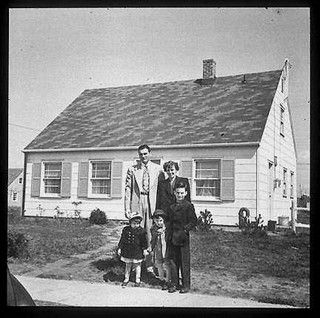

Levittown, Long Island, New York, 1948: the Post-War American Dream and a Publicity Photo for Levittown as featured in a local real estate brochure
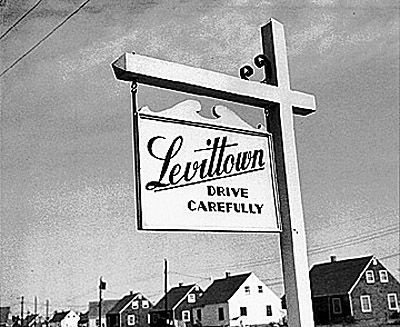
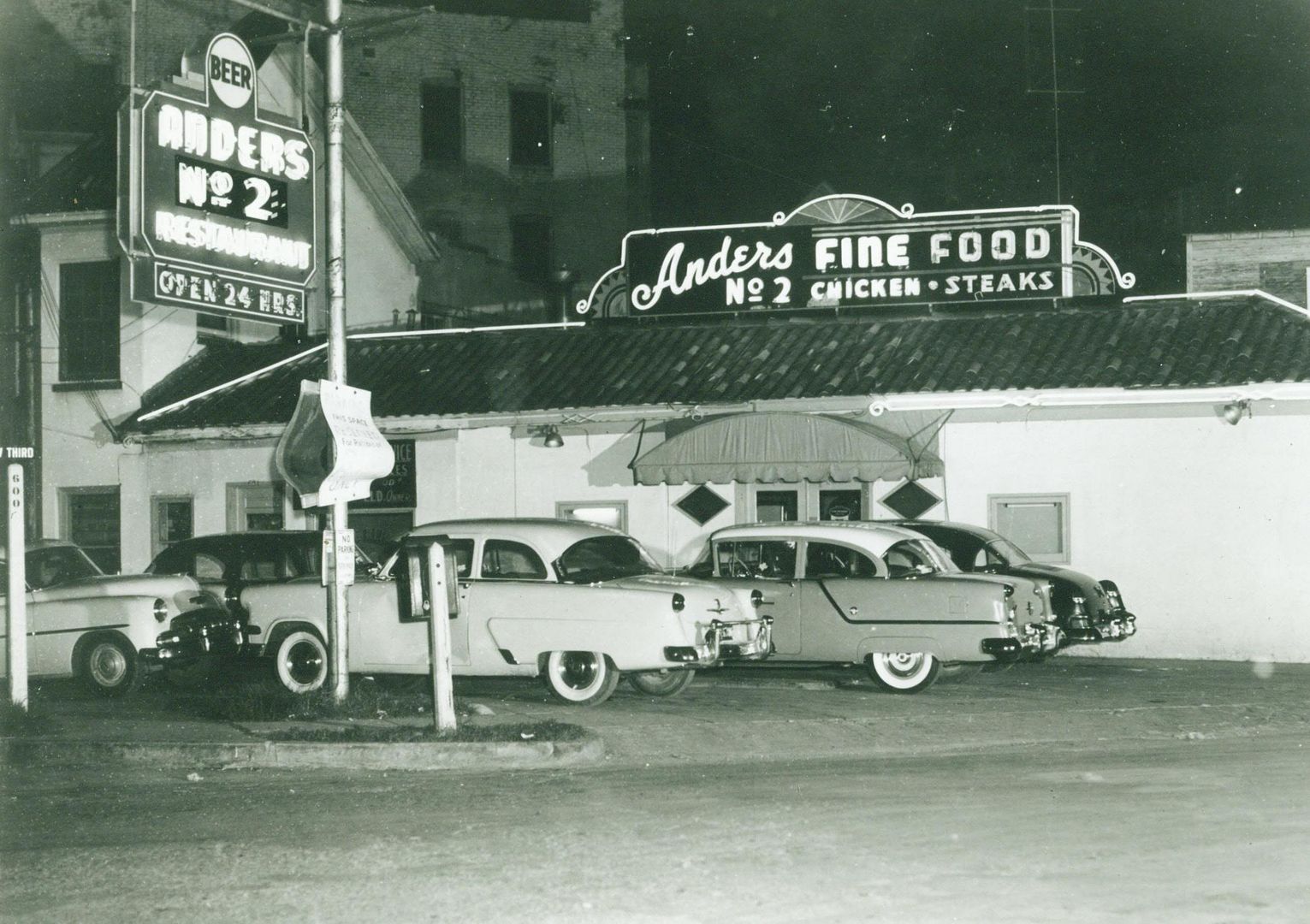
A street sign in Levittown, New York, 1948 and a 1950's Diner
Levittowners came from diverse backgrounds, but as new homeowners with families they shared many of the same concerns and interests. Community life reflected both the inherent diversity of Levittown's residents and their new-found commonality.
:: ::

From 1946-1950, 18.2 million baby boomers were born compared to 14.6 million in the preceding five years from 1941-1945. This increase of 3.6 million children (a 24% increase) put enormous demands on school systems around the country. The country was getting younger as total population increased by 14 million (or only 10%) from approximately 141 million in July 1946 to approx. 155 million by July 1951.
The late Herbert Block (Herblock to his many fans) drew this 1955 cartoon to indicate the demands put on existing schools.
:: ::
"Be sure to give mine special attention"
The baby boom generation pushed the limits of available school resources, contributing to overcrowding, substandard buildings, and teacher shortages. President Dwight Eisenhower hosted the first White House Conference on Education shortly after this cartoon appeared but he hesitated to secure needed funding.
Herblock, Washington Post, November 23, 1955
(click link for larger image)
:: ::
4. Children of the Cold War
The Cold War was primarily an ideological battle between the United States and its NATO allies against the Soviet Union and its Warsaw Pact partners. It permeated American society on different levels and affected daily lives not only in discernible but also subtle, not-so-obvious ways. While it never resulted in direct conflict between the two superpowers, there were plenty of proxy wars all around the globe that shaped the boomers' psyche. As the baby boomers were growing up -- and particularly in later years -- their understanding of what was at stake during this struggle, how it was conducted, and the means used to achieve national ends would color their thinking for decades to come.
Why did the wartime alliance between the United States and Soviet Union unravel so quickly after the end of World War II and affect American society in ways large and small? After all, the two countries had joined hands during the war -- even if it was a "marriage of convenience" -- to confront international Fascism and imperialism. The origins of the Cold War are many, complex, and beyond the scope of this diary. Generally speaking, historians and international relations specialists fall into three camps.

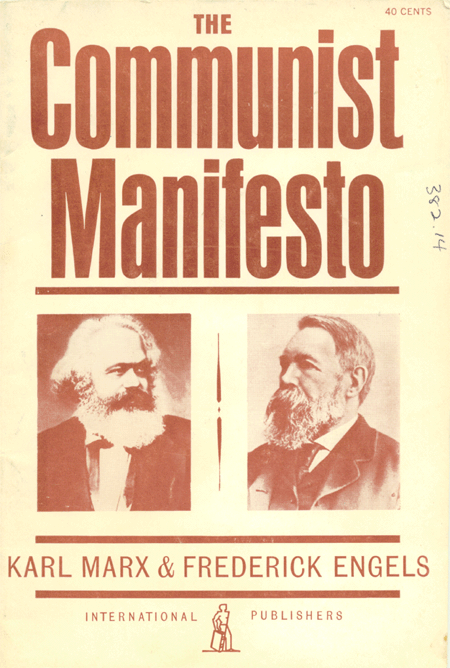
Two books that changed the world, The Wealth of Nations by Adam Smith and The Communist Manifesto by Karl Marx and Friederich Engels
- One explanation is that given its self-proclaimed ideological aim to spread world Communism, the Soviet Union had expansionist designs in Western Europe and, as promised during wartime conferences, never really "freed" the occupied territories in Eastern Europe. The Soviets had historically been leery of foreign invaders and desired a sphere of influence around its borders for security reasons. Having suffered by far the largest number of casualties in a brutal war of survival against the Germans and unprecedented internal destruction, it also wasn't about to easily give up on its hard-fought gains and new-found international prestige.
- Another interpretation is that the United States -- unlike virtually every other war combatant -- emerged not only victorious but also economically strengthened by the end of the war. To paraphrase Shakespeare, it bestrode the world like a colossus. It had also expended a great deal of its treasure to secure victory and being the only country to possess nuclear weapons at the time (an advantage since the Soviet didn't possess that capability until 1949) wanted to flex its political, military, and economic muscles to seek new markets and remake Western Europe -- and the world -- in its image in such a way so as to prevent future intra-European conflicts as well as to protect its war investment.
- A third camp asserts that given the inherent differences between the two political and economic systems -- one democratic and capitalist, the other totalitarian with a command economy -- ideological conflict was inevitable. Hence, absent a common enemy, mutual pre-war animosities and fears were easily revived only a few months after World War II ended. Even the best of marriage goes through its ups and downs and certainly one necessitated by conditions of war wasn't destined to last for long.
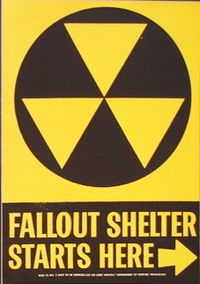
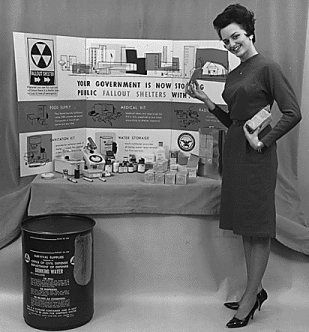
1950's promotion of products to stock in a Nuclear Fallout Shelter
The relevant fact is that that this war of ideas was conducted in a way which would affect virtually every aspect of American life for well over four decades. Almost every major foreign policy decision was viewed through this prism. In that respect, the baby boomers were the true children of this ideological, political, and economic conflict -- though not entirely without hot wars involving one of the two superpowers or their surrogates -- and one that had an enduring impact upon their early lives
The impact of a Cold War context on the culture of the 1950s cannot be understated. The consciousness of the possibility of both nuclear annihilation and also totalitarian subversion created a climate of emotional and psychological unease...
The paranoia of the post-bomb culture found political expression in the House Un-American Activities Committee and the person of Wisconsin Sen. Joseph McCarthy. McCarthy initiated and oversaw Senate investigations into the various members of government, entertainment and news media, and society whom he and others accused of harboring Communist sympathies and aiding Communist subversion of American culture. Six million citizens were investigated before McCarthy was finally condemned by the Senate and stripped of investigatory power.
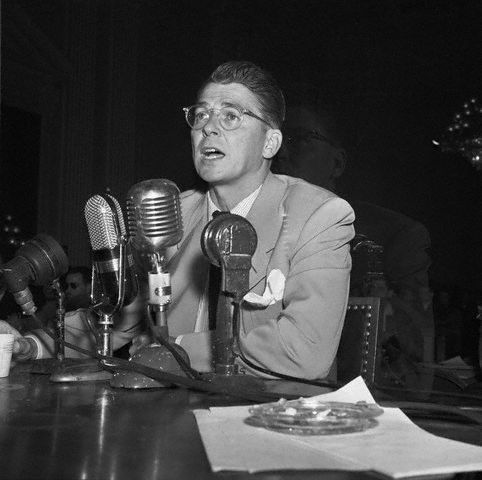
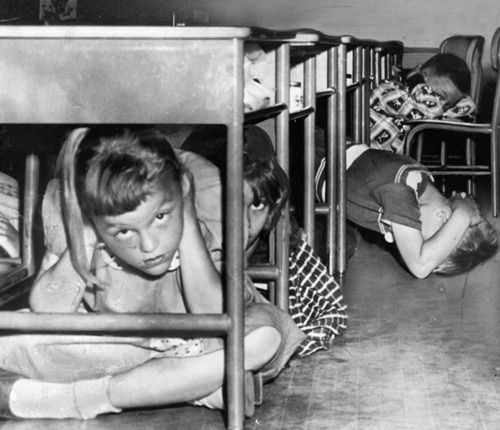
Screen Actors Guild President Ronald Reagan testifying before the House Un-American Activities Committee in 1947 and school children in a "duck and cover" 1950's bomb drill
:: ::
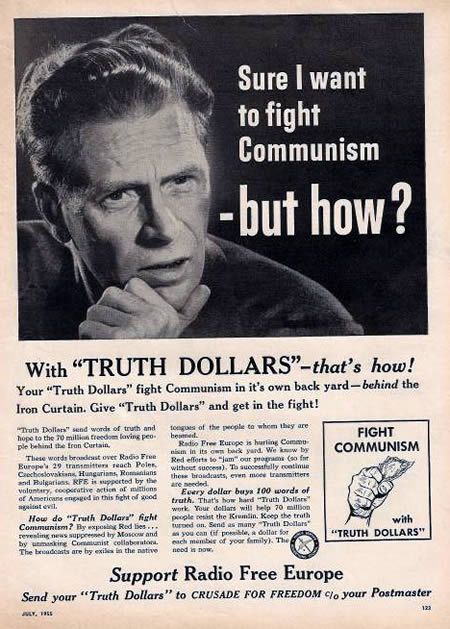

A 1950’s Propaganda ad from Radio Free Europe, printed in Better Homes and Gardens magazine and Senator Joe McCarthy brandishing one of his infamous lists of Communist "sympathizers and infiltrators" throughout the United States government
:: ::
After the Korean War ended in a stalemate in 1953, Communists -- and the Soviets in particular -- were portrayed as savage beasts capable of imposing a draconian system of government over the American people were they to win this ideological struggle. The purpose of these 1950's and 1960's propaganda posters was to highlight the perceived dangers during this period of the "Red Scare."
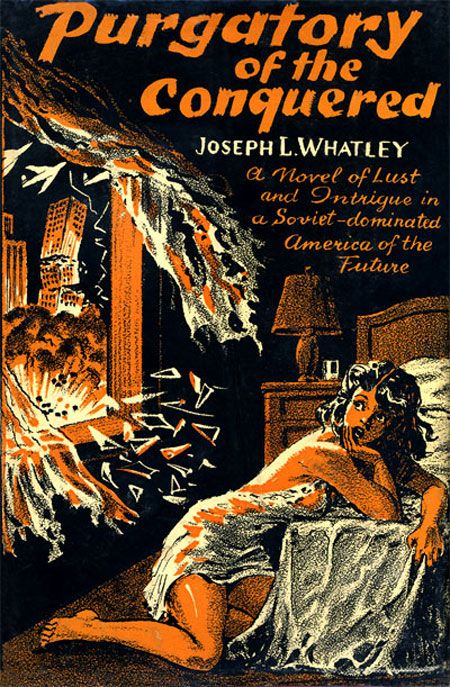
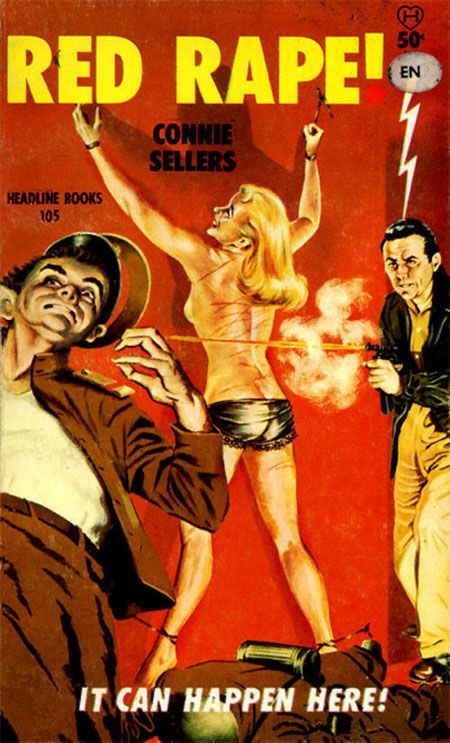
Propaganda posters depict American life under the Soviet system and the evils they were capable of inflicting upon ordinary citizens
:: ::

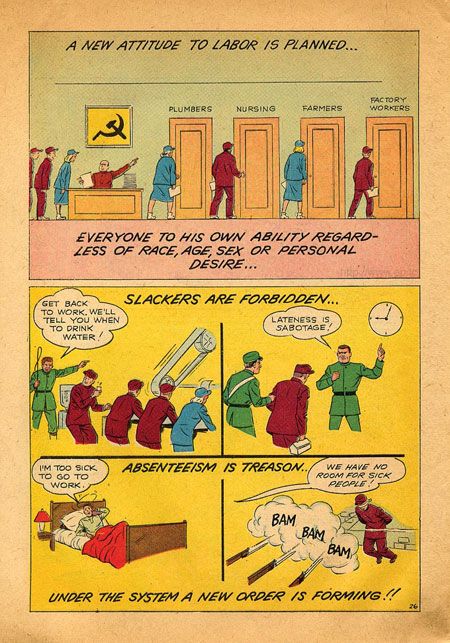
A comic book cover sees the Soviet Union as an iceberg capable of sinking the United States and an 1961 Christan comic book warning against the dangers of Communism
Additional Images and Videos
- See more Cold War propaganda posters from the United States. Note: Canadair was a Canadian manufacturer that built civilian and military aircraft and in 1952 became a subsidiary of General Dynamics. More posters here.
- These two 1950's Cold war propaganda videos promote the "duck and cover" drills and explain the differences between Communism and capitalism.
- See this video about nuclear war paranoia and fallout shelters from The Atomic Cafe which "craftily captures a panicked nation, offering a fascinating and witty account of life during the atomic age and resulting cold war, when fall-out shelters, duck-and-cover drills, and government propaganda were all a part of our social consciousness."
- Read this 1961 Christian comic book pictured above in full. Click on each panel to get to the next one. There were plenty of fundamentalists even then although their prime obsession was anti-Communism. Only later on -- as the present-day born again, evangelical movement came into prominence in the 1970's and 1980's -- did they start to focus relentlessly on their "Family Values" agenda.
Ultimately, all demagogues overreach and fade away into obscurity. So was the case with Senator Joe McCarthy (R-WI). Legendary CBS journalist Edward R. Murrow exposed McCarthy's fear-mongering tactics in a series of broadcasts in his documentary series, See it Now. In the 1954 Army-McCarthy Hearings, a famous confrontation between Senator McCarthy and an attorney representing the U.S. Army, Joseph Welch, contributed significantly to McCarthy's eventual downfall. Only a couple of years later -- with the Democrats regaining control of the U.S. Senate in the 1954 Elections and after his censure that year by the United States Senate -- McCarthy died a broken man.
The Washington Post's editorial cartoonist Herblock -- who coined the term "McCarthyism" in 1950 -- drew a series of cartoons that relentlessly attacked Senator McCarthy for his heavy-handed tactics.
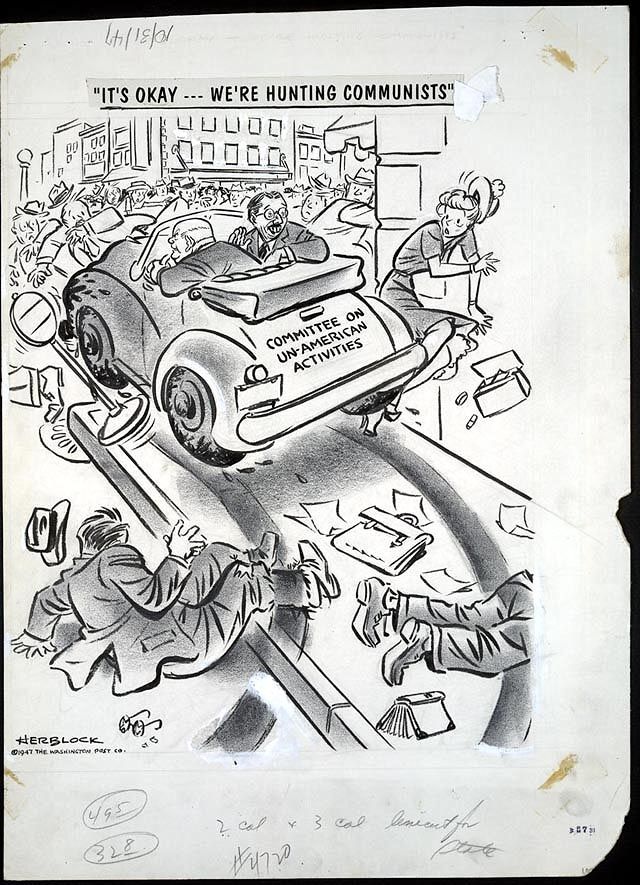
"It's okay – We're hunting Communists"
The Cold War revived the anti-communist hysteria that had gripped the United States after World War I. In 1947 Congress revived the House Committee on Un-American Activities (HUAC), opposed by Herb Block since its inception in the 1930s and declared by President Truman to be itself the most un-American activity. Herb Block comments: "The FBI, under J. Edgar Hoover, helped provide the committee with material from its aptly named 'raw files.' Some producers, directors and screen writers refused to testify or to play the 'name game' in which the committee demanded the names of associates, who could then be called on to name others thus providing an ever-expanding list of suspects to be summoned."
Herblock, Washington Post, October 31, 1947
(click link for larger image)
:: ::
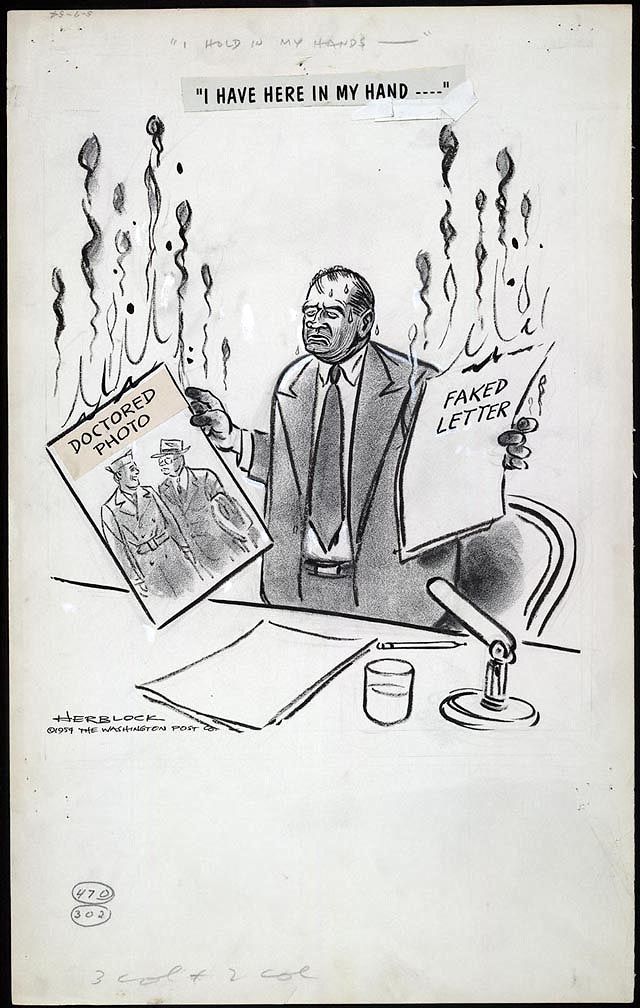
"I have here in my hand..."
In 1954, Senator Joseph McCarthy went too far when he took on the United States Army, accusing it of promoting communists. The Senate held special hearings, known as the Army-McCarthy hearings, which were among the first to be televised nationally. In the course of testimony McCarthy submitted evidence that was identified as fraudulent. As both public and politicians watched the bullying antics of the Senator, they became increasingly disenchanted. Before the year was out McCarthy, whose charges had first hit the headlines in February 1950, was censured by his colleagues for "conduct unbecoming a senator."
Herblock, Washington Post, May 7, 1954
(click link for larger image)
:: ::
5. Rumblings of Political and Social Social Change
At the end of World War II in 1945, millions of young men and women returned home after helping to defeat Fascism in Europe and imperialism in Asia. Among them were over one million African-American soldiers long denied basic civil and human rights in their own country.
The road to equality overcame a major hurdle in 1948 as I wrote in this diary over a year ago
"A Dismaying Document"
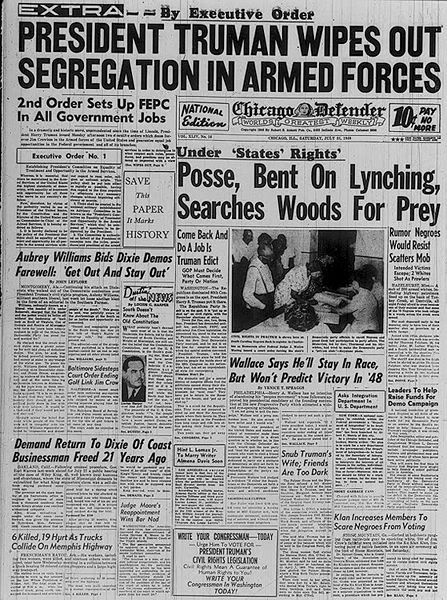
Chicago Defender, July 31, 1948
Note: The Chicago Defender, which was founded by Robert S. Abbott on May 5, 1905, once heralded itself as "The World's Greatest Weekly." The newspaper was the nation's most influential black weekly newspaper by the advent of World War I, with more than two thirds of its readership base located outside of Chicago.
It was one of those moments in American history that not only provided hope for millions of minorities denied basic civil rights for generations but gave encouragement to all fair-minded and rational-thinking persons in this country.
It is also important to remember the man who was responsible for this historic decision, considered to be the first major action of the modern civil rights movement. He was a most unlikely candidate to advance the cause of civil rights and attempt to exorcise the demons of racial segregation and remnants of this country's original sin. When he submitted his civil rights bill to the U.S. Congress, a southern newspaper referred to it as
A dismaying document based on a pernicious fallacy. Here we have the making of a veritable Gestapo.
Nothing in his Missouri upbringing and background suggested such a move. Yet, even with powerful political forces aligned against him in his own Democratic Party, he did just that. On July 26, 1948, with one stroke of his pen, President Harry S Truman signed Executive Order 9981 and desegregated the Armed Forces of the United States. He believed that after well over a million African Americans had enlisted in the armed services in World War II to fight against the mother of all racist regimes in Europe, Adolf Hitler's Third Reich -- and with racially-motivated crimes on the rise in post-war years -- the moment had arrived for the country to live up to its professed ideals and for all Americans to be treated equally in the service of their country.
It was a major blow to many whites in this country who had long believed in the inherent superiority of the white race and, contrary to historical evidence, an unshakable belief in their ability -- and theirs alone -- to defend this country against all enemies foreign or domestic.
It took many years to fully implement Truman's executive order to achieve complete desegregation in the armed forces and while it was an important first step, conditions for African-Americans in this country were hardly on par with their white brethren. The Washington Post editorial cartoonist Herblock depicted these horrific conditions in this cartoon
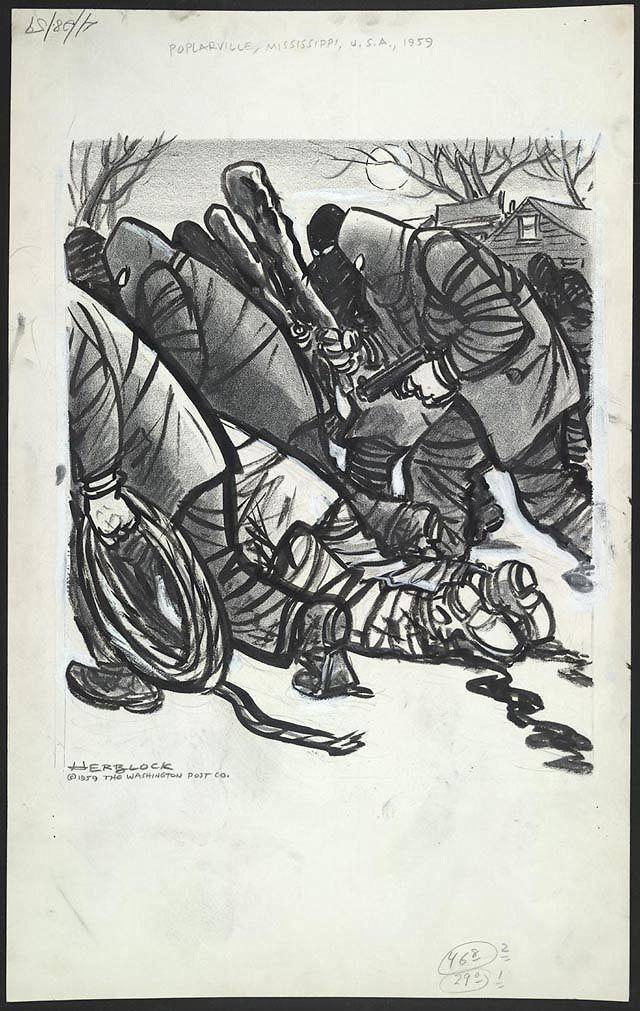
With the end of World War II in 1945, social issues such as poverty, education, housing, and civil rights returned to the American political arena as soldiers returned, seeking jobs and homes. Black soldiers sought social justice and economic equality; women looked to further their growing participation in the nation's workforce; and families worked harder to educate their children. For some, the G.I. Bill and personal ambition fueled their American dream of prosperity and independence. For others, the dream still seemed beyond reach. link
Although in the 1950s some progress was made toward attaining civil rights for African Americans, lynchings continued until the late 1960s. On April 25, 1959, a group abducted Charles Parker from prison in Poplarville, Mississippi where he awaited trial on charges of raping a white woman. On May 4, the FBI found his body in the Pearl River near Bogalusha, Louisiana, executed with two bullets. The Governor of Mississippi said he would bring the matter before a grand jury at its next regular session months later.
(Herblock, Washington Post, April 28, 1959 - (click link to enlarge cartoon)
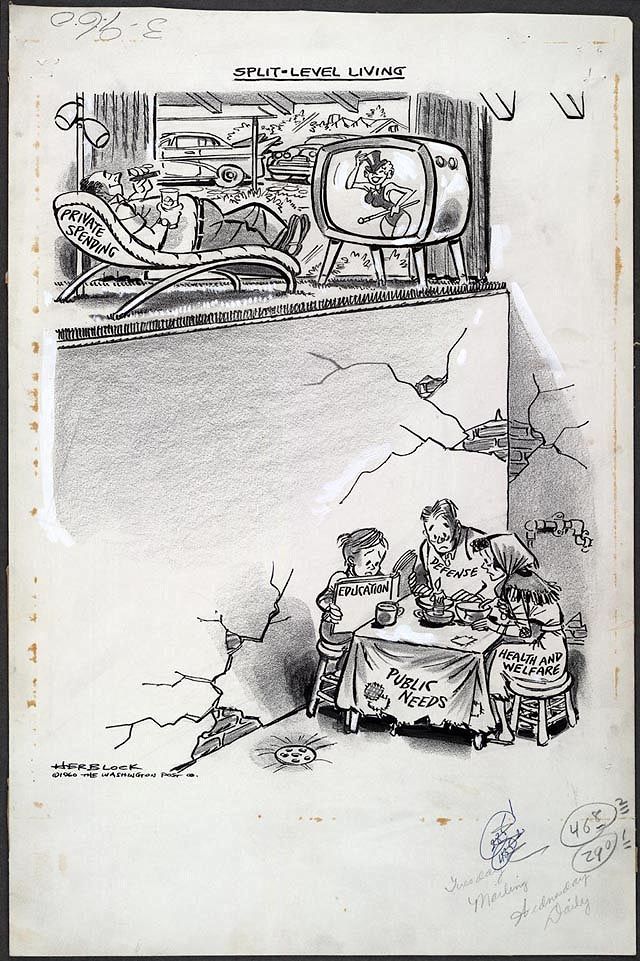
Split-level Living
Following World War II, construction of single-family housing exploded in suburbia, the "split-level" house being one of the more popular models. By 1960, the gross national product, the consumer price index, and personal income had reached all-time highs. At the same time, critics said President Dwight Eisenhower had failed to provide more spending needed for education, for economic and social programs, especially for those Americans left out of the general prosperity.
(Herblock, Washington Post, March 9, 1960 - click link to enlarge cartoon)
In 1955, the horrific murder of fourteen-year old Emmett Till in Mississippi galvanized the Civil Rights Movement, particularly when his mother insisted on showing his mangled body at his funeral. The emergence of Rosa Parks (often referred to as the "Mother of the modern Civil Rights Movement") in December 1955 -- when she refused to give up her bus seat to a white passenger in Montgomery, Alabama -- sparked a protest movement that had important consequences for all minorities in the country. The Reverend Joseph Lowery recalled her contributions in an PBS interview in 2005 the day after her death
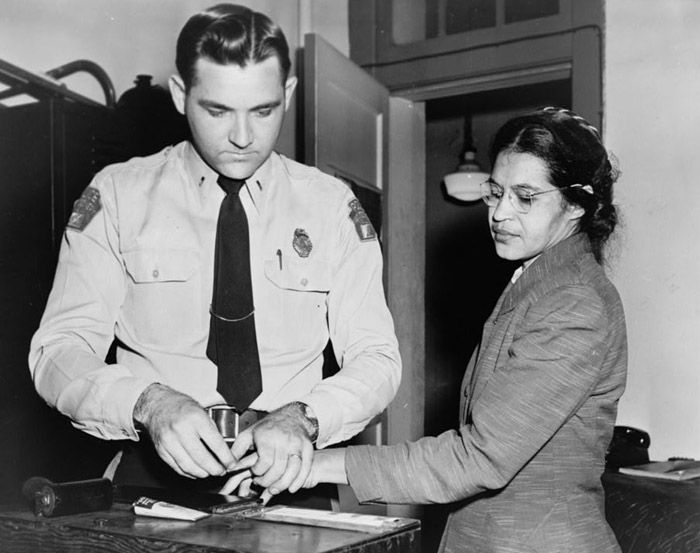
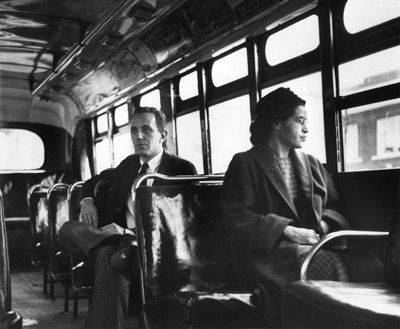
Rosa Parks being fingerprinted by Deputy Sheriff D.H. Lackey in Montgomery, Alabama on February 22, 1956 during her indictment for organizing a bus boycott and riding a bus in December 1956 after the U.S. Supreme Court outlawed segregation on buses
:: ::
She was a gentle spirit that let loose a powerful force against racial injustice, and I think that factor alone inspired the people of Montgomery who nevertheless felt personally involved in the discrimination of the bus.
She was an unlikely person, but she became an instrument of the people's will in that community who were tired. They said she was tired from working and perhaps she was -- but she herself said later that she was spiritually tired and weary of being humiliated by being asked to move back so that a white person could occupy her seat.
It triggered the greatest revolution in American history in terms of nonviolent protest against against segregation and discrimination. And she became the symbol, the queen mother, of that movement.
The 1954 Supreme Court Brown vs The Board of Education decision mandated that all schools be desegregated throughout the country. But many school systems were slow to implement this order and in 1957, President Dwight D. Eisenhower sent federal troops to forcibly integrate Little Rock Central High School in Little Rock, Arkansas. Mindful of his political future in a conservative and racially-polarized Southern state, Governor Orval Faubus (D-AR) vowed to block it and deployed the Arkansas National Guard to prevent entry by nine African-American students who came to known as 'The Little Rock Nine.'
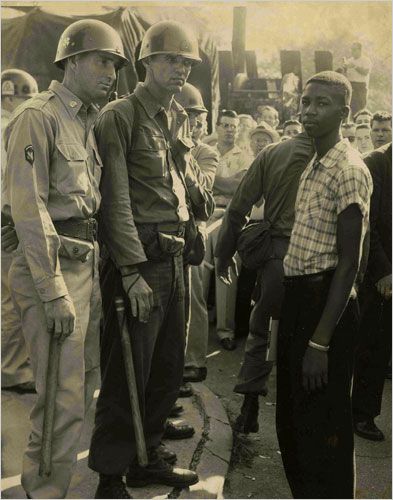
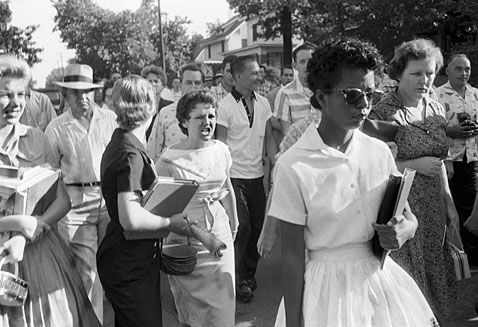
Arkansas National Guard troops block entry by African-American students into Little Rock Central High School and Elizabeth Eckford bravely walks through a hostile crowd of white students and their parents
Under protection of federal troops over the next year or so, the students persevered in a very hostile climate which included daily threats and verbal abuse. The nine students ultimately prevailed and their efforts garnered major national headlines on television and in newspapers.
The Civil Rights Movement had won an important victory against state-instigated violence and racism. The movement would pick up considerable steam in the years ahead.
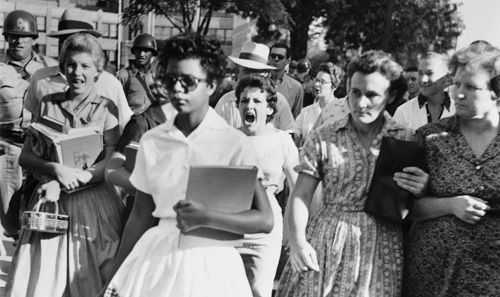
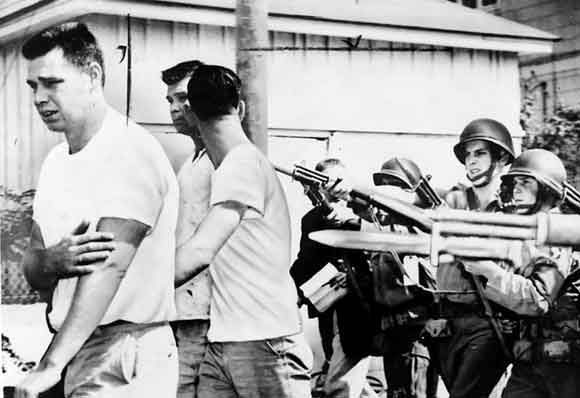
Elizabeth Eckford walks away after being denied entry into the school and the 101st Airborne troops doing crowd control at Little Rock Central High School
No images were more striking, or more heartbreaking, than those of 15-year-old Elizabeth Eckford.
She had arrived first, and alone. Angry swarms of white people confronted her, jeering, chanting, and shouting epithets. Three times she tried to enter the school. Each time soldiers barred her from entering, and, the third time, directed her away.
She walked on, toward a bus stop, seeking a bus to take her to safety. A photograph -- one of the most enduring images of the civil rights movement in the United States -- shows her walking away from the school. She is starkly and completely alone, and easily within striking distance of those at the front of the large and frightening crowd of white people following her.
It is impossible to look at this searing photograph without trying to comprehend what young Elizabeth Eckford might have been thinking and feeling at that time. It is painful to contemplate how frightened she must have been and how alone and vulnerable she must have felt.
link
For almost a decade from the mid-1950's on, a number of other important events during this resistance struggle for equality highlighted the plight of the poor and oppressed minorities in this country. These include
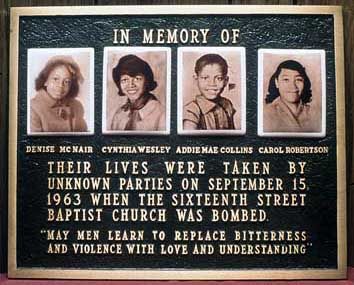
- In 1957, Martin Luther King, Charles K. Steele, and Fred L. Shuttlesworth establish the Southern Christian Leadership Conference, of which King is made the first president. The SCLC becomes a major force in organizing the civil rights movement and bases its principles on nonviolence and civil disobedience. According to King, it is essential that the civil rights movement not sink to the level of the racists and hatemongers who oppose them: "We must forever conduct our struggle on the high plane of dignity and discipline," he urges.
- Four black students from North Carolina Agricultural and Technical College (in Greensboro, North Carolina) begin a sit-in at a segregated Woolworth's lunch counter in February 1960. Although they are refused service, they are allowed to stay at the counter. The event triggers many similar nonviolent protests throughout the South. Six months later the original four protesters are served lunch at the same Woolworth's counter. Student sit-ins would be effective throughout the Deep South in integrating parks, swimming pools, theaters, libraries, and other public facilities.
- The Student Nonviolent Coordinating Committee (SNCC) is founded at Shaw University in Raleigh, North Carolina in April 1960, providing young blacks with a place in the civil rights movement. The SNCC later grows into a more radical organization, especially under the leadership of Stokely Carmichael.
- Over the spring and summer of 1961, student volunteers begin taking bus trips through the South to test out new laws that prohibit segregation in interstate travel facilities, which includes bus and railway stations. Several of the groups of "freedom riders," as they are called, are attacked by angry mobs along the way. The program, sponsored by The Congress of Racial Equality (CORE) and the Student Nonviolent Coordinating Committee (SNCC), involves more than 1,000 volunteers, black and white.
- About 200,000 people join the March on Washington in August 1963. Congregating at the Lincoln Memorial, participants listen as Martin Luther King delivers his famous "I Have a Dream" speech.
- Four young girls (Denise McNair, Cynthia Wesley, Carole Robertson, and Addie Mae Collins) attending Sunday school are killed when a bomb explodes at the Sixteenth Street Baptist Church in September 1963, a popular location for civil rights meetings. Riots erupt in Birmingham, leading to the deaths of two more black youths.
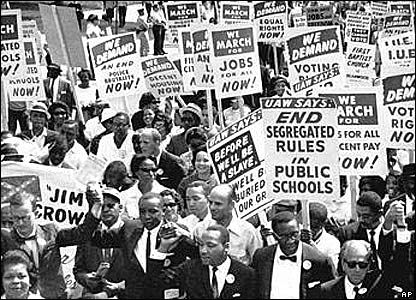

Scenes from the 1963 March on Washington organized by leaders and members of the Civil Rights Movement and one of the first artifacts of the movement collected by the Smithsonian, this button was brought in by an employee who participated in the march.
:: ::
Read about more important events during the long Civil Rights Struggle
:: ::
As the 1950's started to wind down and with early baby boomers entering their teenage years -- the so-called "Wonder Years" -- cultural seeds were being sown that would later come to define the anti-establishment and counterculture 1960's. From rock music to comedy to movies to television to literature, a kind of restlessness and rebellion was bubbling up amongst the country's youth. Many in the Beat Generation led the way
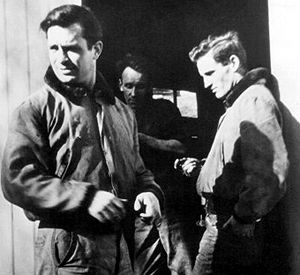
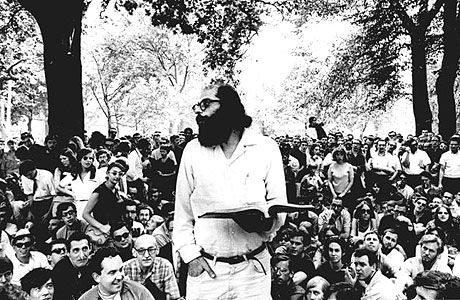
Some of the leading figures of the Beat Movement included Jack Kerouac and Neal Cassady (left) and Allen Ginsberg (AP photo on right)
:: ::
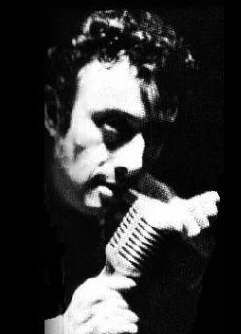
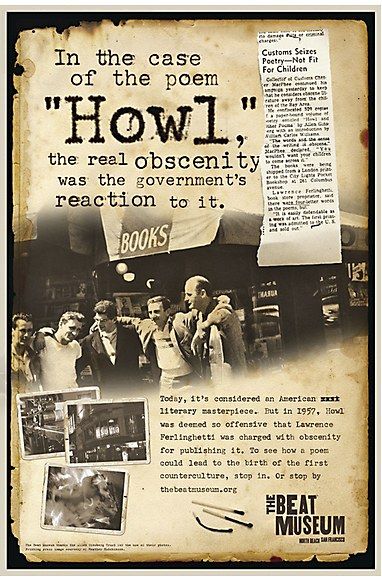
Social critic and satirist Lenny Bruce (left) and a poster about Ginsberg's famous and controversial poem "Howl" (courtesy of the Beat Museum)
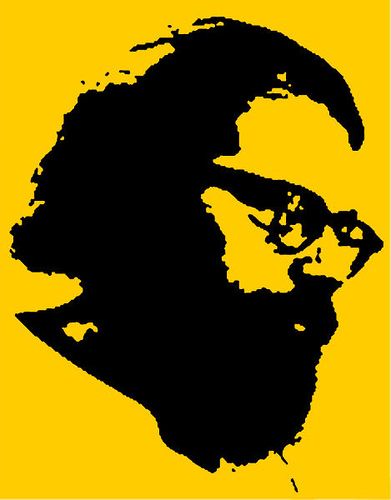
Allen Ginsberg's "Howl" - the Poem That Triggered the Counterculture Movement
On 7 October 1955, at the Six Gallery in San Francisco, Allen Ginsberg brought the house down with a performance of his hallucinatory new poem, Howl. Among other things, this epic work in four parts dealt with drugs, mental illness, religion, homosexuality – the fears and preoccupations of a generation. Jack Kerouac and Lawrence Ferlinghetti were both in the audience. Ginsberg was 29 years old.
I saw the best minds of my generation destroyed by
madness, starving hysterical naked,
dragging themselves through the negro streets at dawn
looking for an angry fix,
angelheaded hipsters burning for the ancient heavenly
connection to the starry dynamo in the machin-
ery of night,
who poverty and tatters and hollow-eyed and high sat
up smoking in the supernatural darkness of
cold-water flats floating across the tops of cities
contemplating jazz,
who bared their brains to Heaven under the El and
saw Mohammedan angels staggering on tene-
ment roofs illuminated,
who passed through universities with radiant cool eyes
hallucinating Arkansas and Blake-light tragedy
among the scholars of war,
who were expelled from the academies for crazy &
publishing obscene odes on the windows of the
skull,
who cowered in unshaven rooms in underwear, burn-
ing their money in wastebaskets and listening
to the Terror through the wall
-- Allen Ginsberg, Howl
:: ::
A lot of what happened in later years had its roots in the 1950's. Author David Halberstam wrote an important book about the decade, The Fifties. You can watch his interview with Brian Lamb on C-Span's 'Booknotes' in which Halberstam discusses his book over the course of the hour.
Two book reviews summarize his book
- "In retrospect," writes David Halberstam, "the pace of the fifties seemed slower, almost languid. Social ferment, however, was beginning just beneath this placid surface." -- Amazon.com Review.
- The Fifties were more than just a mid-point decade in a century; they were to be the crucible in which the rest of the 20th century was forged. Halberstam here touches every thread in the warp and woof of the national fabric... Halberstam also explores major social and cultural changes -- the advent of national television, fast-food restaurants, the flight to the suburbs, huge cars with fins, the phenomenon of Elvis Presley, the contraceptive pill, and much more. -- Library Journal
:: ::
6. The Age of Camelot and "Loss of Innocence"
The election of John F. Kennedy in November 1960 was like a breath of fresh air blowing throughout the entire land. The staid, predictable 1950's which ushered in the politics of superficial tranquility and an era of conformity was drawing to a close. If the country had largely coasted through the previous decade, new frontiers and possibilities suddenly appeared over the horizon. The charismatic, young President challenged all Americans to work harder to give of themselves to their country and to scale new heights. Optimism and excitement seemed to be the new buzz words. It was to be the dawn of a new period of American renewal in more ways than one.
As President Kennedy himself expressed it so eloquently in his memorable 1961 Inaugural Speech
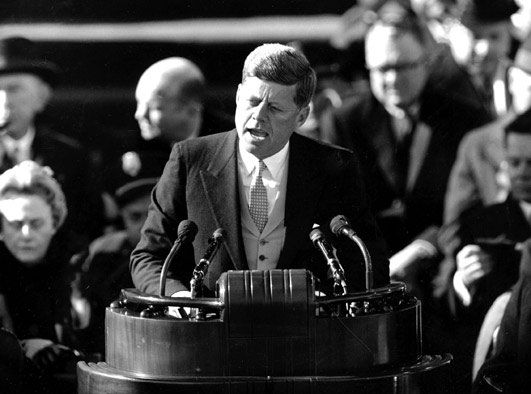
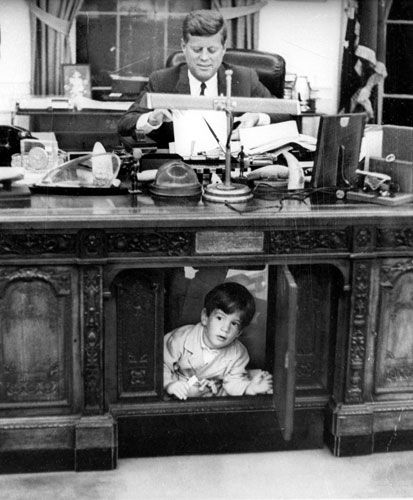
President John F. Kennedy delivering his 1961 Inaugural Speech and two-year old John, Jr. playing under his father's desk in the Oval Office (Photograph: Stanley Tretick/AP)
:: ::
We dare not forget today that we are the heirs of that first revolution. Let the word go forth from this time and place, to friend and foe alike, that the torch has been passed to a new generation of Americans -- born in this century, tempered by war, disciplined by a hard and bitter peace, proud of our ancient heritage -- and unwilling to witness or permit the slow undoing of those human rights to which this Nation has always been committed, and to which we are committed today at home and around the world.
Let every nation know, whether it wishes us well or ill, that we shall pay any price, bear any burden, meet any hardship, support any friend, oppose any foe, in order to assure the survival and the success of liberty.
This much we pledge -- and more.
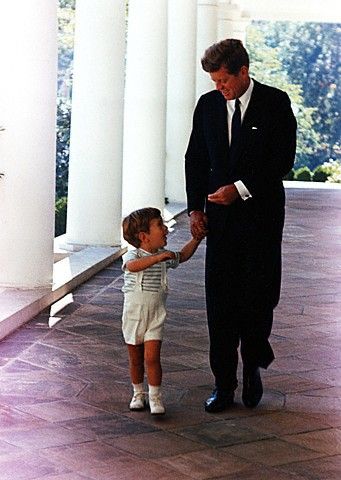
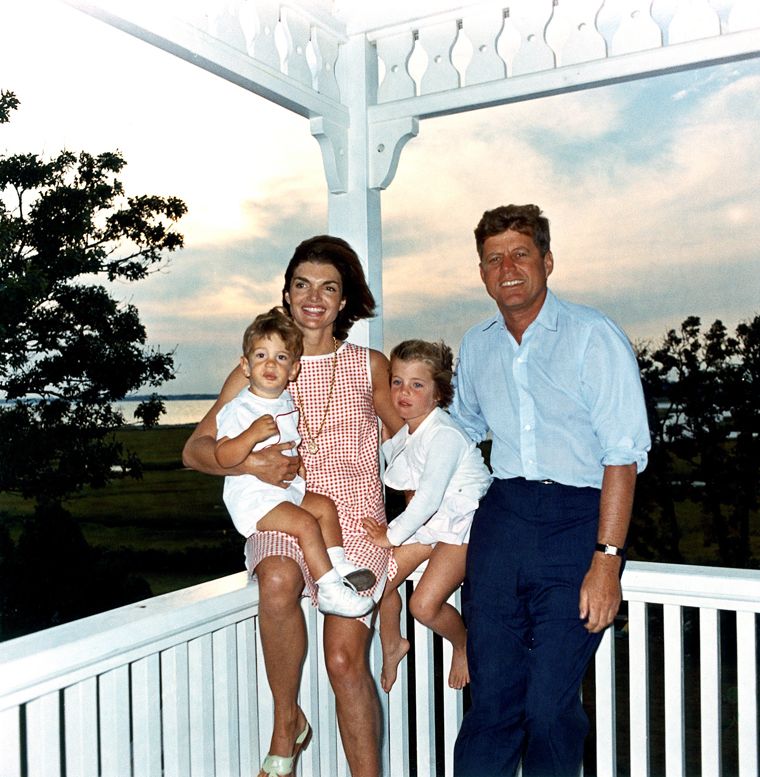
John, Jr. takes a stroll in the White House with his father and the Kennedy Family (Jackie, John, Jr., Caroline and Jack) in Hyannisport, Massachusetts
:: ::
In another blow to segregationists, James Meredith became the first African-American student admitted to the University of Mississippi in Oxford, MS in 1962. His admission sparked race riots that left two people killed, 160 soldiers injured, and 26 U.S. Marshals wounded by gunfire. Later that year, Bob Dylan wrote a song about this famous incident called 'Oxford Town'
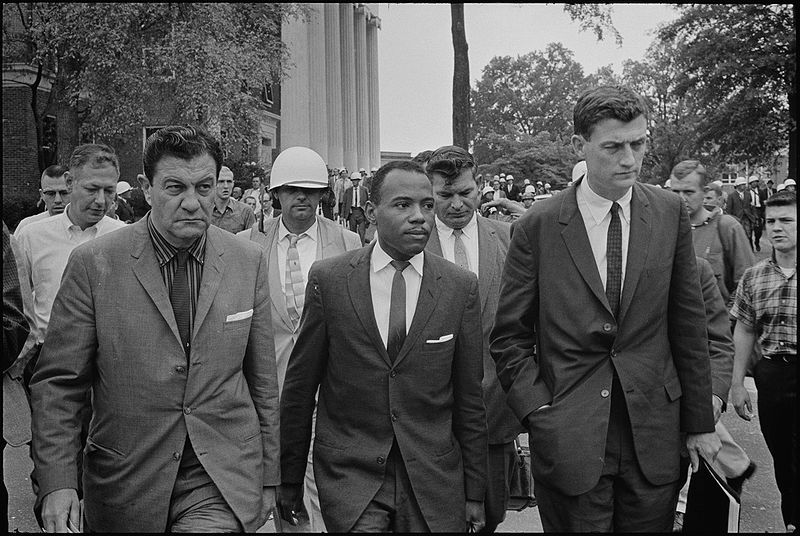
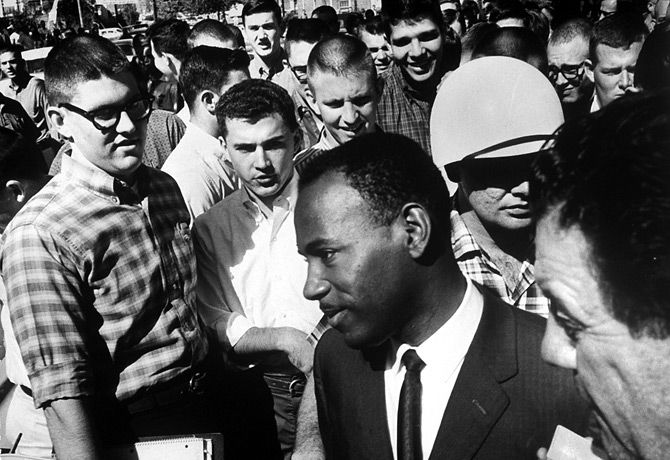
Escorted by U.S. Marshals and protected by U.S. army military police, James Meredith walks through an angry crowd of white students at the University of Mississippi.
:: ::
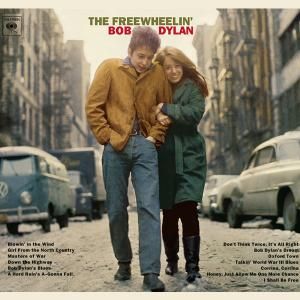
Oxford Town
He went to down to Oxford Town
Guns and clubs followed him down
All because his face was brown
Better get away from Oxford Town
Oxford Town around the bend
He come to the door, but couldn't get in
All because of the color of his skin
What do you think about that, my frien'?
Me and my gal, my gal's son
We got met with a tear gas bomb
I don't even know why we come
Goin' back where we come from.
Oxford Town in the afternoon
Ev'rybody singin' a sorrowful tune
Two men died 'neath the Mississippi moon
Somebody better investigate soon.
-- 'Oxford Town', Bob Dylan, (1962), the song on YouTube
:: ::
In 1960, the first birth control pill was approved by the Food and Drug Administration. It would take another decade and legal challenges to make it widely available for all women -- married or unmarried -- in 1972.
In 1963, author Betty Friedan wrote her book The Feminine Mystique, one which examined the role of women in American society. It is widely credited with having ignited the modern women's rights movement and started the long march towards achieving financial independence for millions of working women
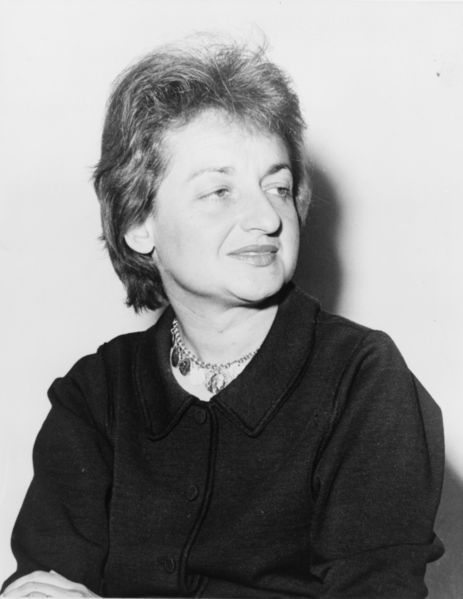
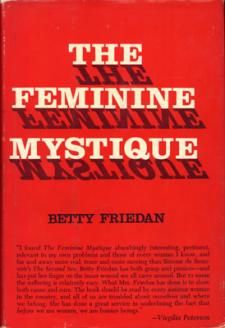
:: ::
The Feminine Mystique was published in 1963 after Friedan sent a questionnaire to other women in her 1942 Smith College graduating class.
Friedan and her classmates all indicated a general dissatisfaction with their lives. This led Friedan to conduct more detailed research into "the problem that has no name" -- the Feminine Mystique. She defined this "mystique" as the worthlessness women feel in roles that require them to be financially, intellectually and emotionally dependent upon their husbands. Through her findings, Friedan hypothesized that women are victims of a false belief system that requires them to find identity and meaning in their lives through their husbands and children.
:: ::
When President Kennedy died that fateful day in Dallas, Texas, he had become the fourth president to be assassinated while in office. With him died the dreams of millions of his supporters and admirers he had inspired during his short stay in office. We'll never know how he might have fulfilled his considerable potential but he did have several notable accomplishments: preventing nuclear war with the Soviet Union during the Cuban Missile Crisis; managing a prosperous economy that had been stagnant towards the end of the Eisenhower Administration; initiating an expanded space program that led to man's landing on the man within the decade; and introducing a civil rights bill that became the law of the land the year after his death.
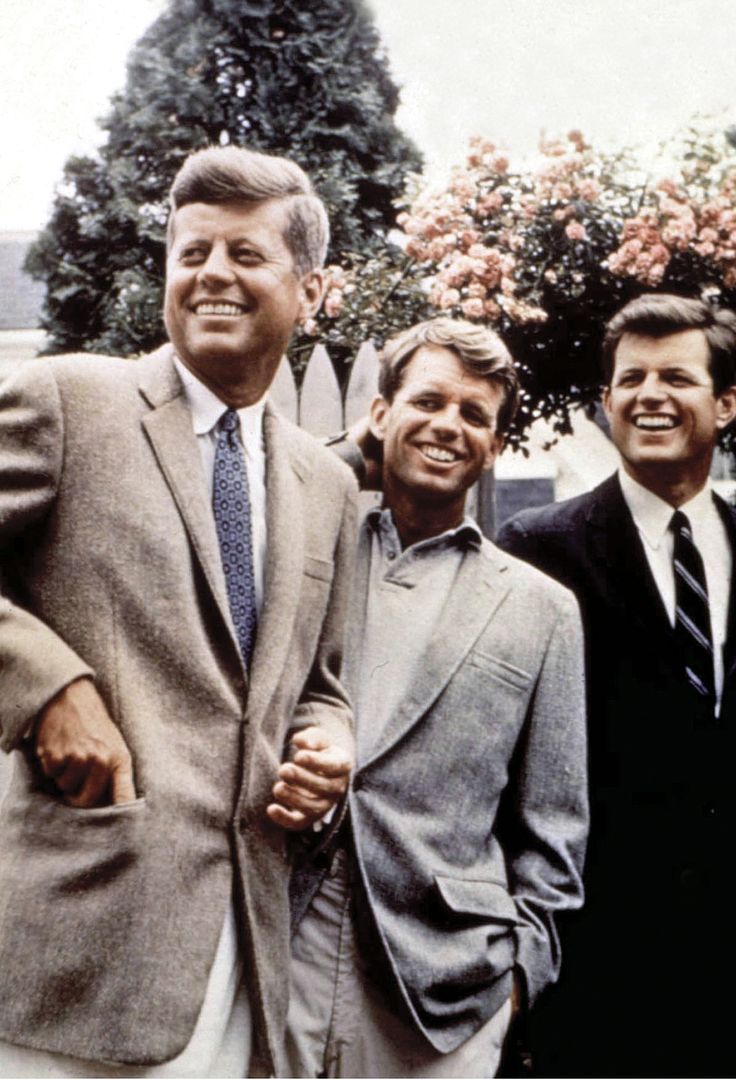
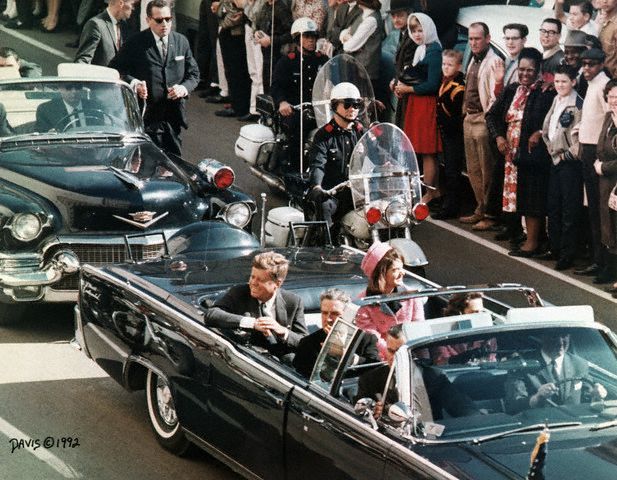
President Kennedy with his brothers Bobby and Ted in the White House and JFK with Jackie and Governor John Connally (D-TX) on November 22, 1963 moments before he was assassinated in Dallas, Texas
:: ::
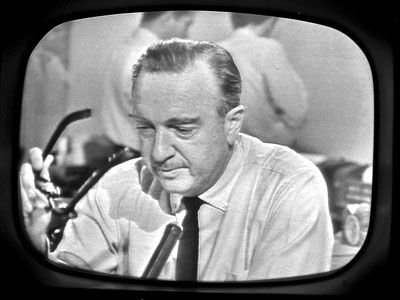
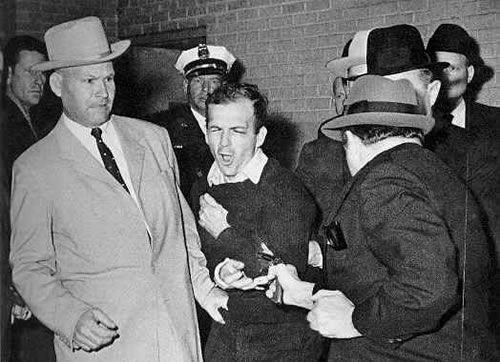
CBS Anchorman Walter Cronkite announces JFK's death on November 22, 1963 to a stunned nation and two days later, nightclub owner Jack Ruby shoots suspected JFK assassin Lee Harvey Oswald
:: ::
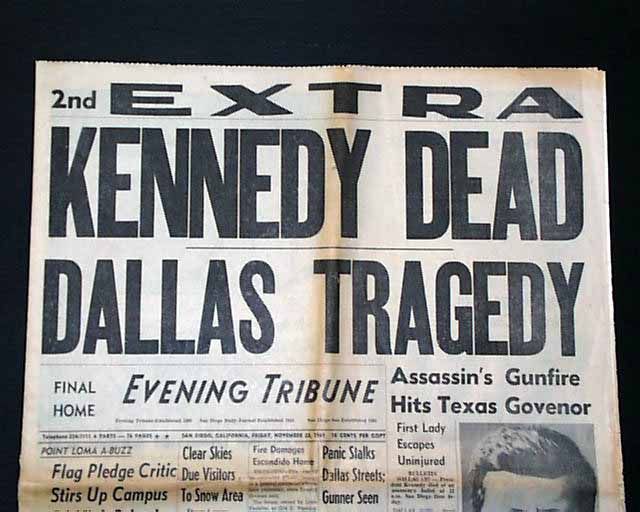
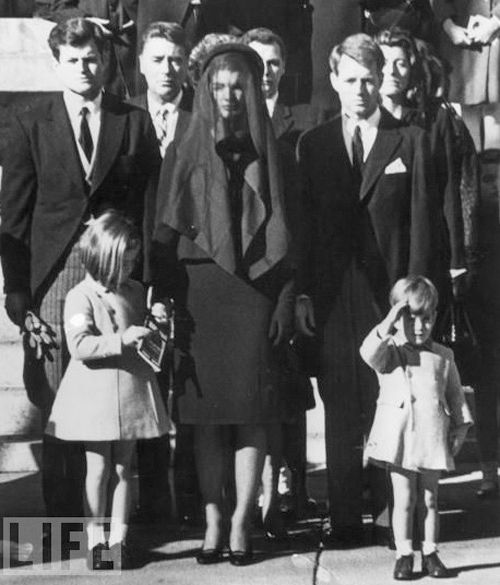
JFK's death as announced by the San Diego Evening Tribune on November 22, 1963 and John, Jr. salutes his father's casket on November 25, 1963 in Washington, D.C.
:: ::
At any given point in a country's history, societies experience multiple trends that run simultaneously on different and, often, contradictory tracks. So was the case with American society and the Baby Boom generation from their early childhood years on to adulthood. On the one hand, they were the beneficiaries of a sustained period of domestic prosperity but one which saw economic and social privileges largely accruing to white Americans. Their brethren of color had to scratch, claw, and fight for even the most basic of human and civil rights as for them the American Dream remained as elusive as ever. They, too, were long-time citizens of a country that had long denied them rights that should have been rightfully theirs under the professed ideals upon which it had been founded. In the coming years, this struggle would intensify and culminate in the passage of landmark legislation that would grant African-Americans and other minorities basic legal guarantees but not before all hell would break loose over the next decade. This turmoil and conflict was to change this country forever.
It was a necessary and long overdue step towards creating a "more perfect union."
:: ::
To be continued...
:: ::
Almost all of the photographs used in this diary are in the public record. They came from public libraries, historical associations, and libraries at several universities. Where attribution is needed, I've provided it.


